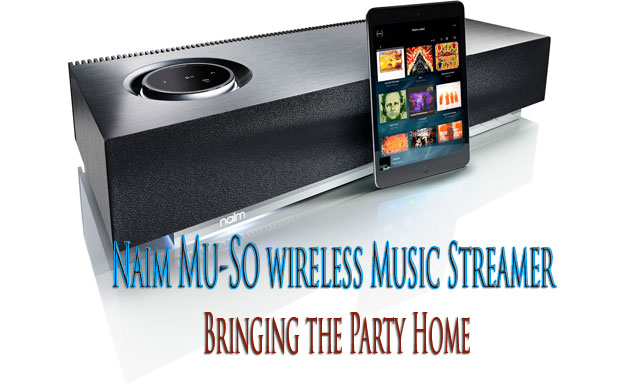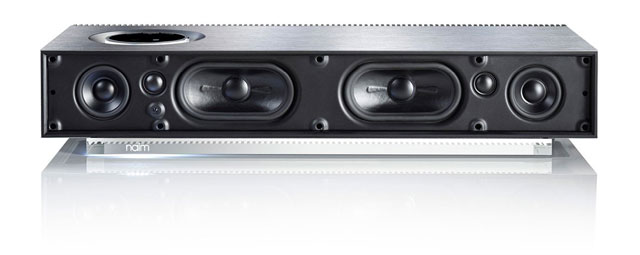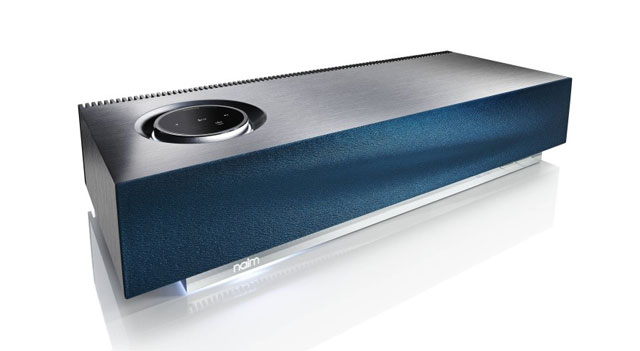Naim Mu-So

 At the core of high-end audio is the ability to bring the experience of recorded music (either live or in studio) into the home. Now for years this brought to mind images of stodgy old farts or bourgeois yuppies sitting in front of stereo systems costing a good portion of the homes they were sitting in, fawning over the minute details that could be heard in the passionless music they were listening too. I can’t count the number of times I’ve sat in a listening room at a high-end show in front of a half million (or million) dollar system with a room full of people and no one seemed to enjoy the music. I mean not one head was bobbing or toe was tapping or finger was snapping to the music’s rhythm. No one was playing air drum despite listening to Buddy Rich. No one was mimicking the guitar despite listening to Lee Ritnour. At most, a few people would express their appreciation for the system’s ability to “render a lifelike image” or “reproduce tuneful bass.” What the f&%k is tuneful bass?! Sadly, it seems as though so much has been put into the wonders of megabuck power cords and ugly, overpriced Erector Set looking equipment racks that all the passion and, quite frankly, fun has been sucked out of bringing high quality audio into the home. Thankfully, one of the off-shoots of the growth of companies like Apple, Spotify, Bose, Sonos and others has been the rise in portable, wireless home audio systems and Hi-Res music downloads. Suddenly, people unencumbered by the restraints of audiophilia are enjoying music in every part of their home (or car or boat or deck or office, etc.) without having to be worried about sweet spots or room tunes or reflective surfaces. So when will the high-end community come and join the “reindeer games” and bring audiophile quality to the neighborhoods? Naim already has.
At the core of high-end audio is the ability to bring the experience of recorded music (either live or in studio) into the home. Now for years this brought to mind images of stodgy old farts or bourgeois yuppies sitting in front of stereo systems costing a good portion of the homes they were sitting in, fawning over the minute details that could be heard in the passionless music they were listening too. I can’t count the number of times I’ve sat in a listening room at a high-end show in front of a half million (or million) dollar system with a room full of people and no one seemed to enjoy the music. I mean not one head was bobbing or toe was tapping or finger was snapping to the music’s rhythm. No one was playing air drum despite listening to Buddy Rich. No one was mimicking the guitar despite listening to Lee Ritnour. At most, a few people would express their appreciation for the system’s ability to “render a lifelike image” or “reproduce tuneful bass.” What the f&%k is tuneful bass?! Sadly, it seems as though so much has been put into the wonders of megabuck power cords and ugly, overpriced Erector Set looking equipment racks that all the passion and, quite frankly, fun has been sucked out of bringing high quality audio into the home. Thankfully, one of the off-shoots of the growth of companies like Apple, Spotify, Bose, Sonos and others has been the rise in portable, wireless home audio systems and Hi-Res music downloads. Suddenly, people unencumbered by the restraints of audiophilia are enjoying music in every part of their home (or car or boat or deck or office, etc.) without having to be worried about sweet spots or room tunes or reflective surfaces. So when will the high-end community come and join the “reindeer games” and bring audiophile quality to the neighborhoods? Naim already has.
It was just a couple of years ago that I visited Pro Musica, one of the best audio shops in Chicago and the proprietors, Ken Christianson and John Schwarz could hardly contain their excitement over an affordable Naim Audio system with a funny name. Now bear in mind that Ken and John have been Naim dealers for more than 30 years and Ken is even a recording engineer for Naim’s record label, so I’ve come to expect a lot of enthusiasm from them over any Naim product. But what was different this time was that they were enthusing over a “system” that can sit on any tabletop and only sells for $1,500! There are companies out there making phono cartridges that cost more than that. You can probably buy one at Pro Musica. What Christianson and Schwarz were enthusing over, was the Naim Mu-so Wireless Audio System.
The Mu-so
The Mu-so is a near perfect marriage of elegant styling, thoughtful design and high-performance music reproduction. It’s a single-chassis unit that houses a 32-bit digital signal processor and six 75-watt amplifiers that drive six Naim-designed drivers. There are an array of source options, including built-in accessibility to things like Internet radio, Spotify, and TIDAL. There are also UPnP connectivity via USB, digital and analog inputs. You can also connect your devices via Bluetooth or Apple Airplay.
Physically, the chassis is 4.8” x 24.7” x 10.1” and made of a silver brushed aluminum with silver anodized heatsinks. The six drive units are built into the front of the chassis and are covered by a removable black fabric grill cloth. As an option, the Mu-so can also be order with a Deep Blue, Burnt Orange or Vibrant Red grill cloth. The total unit weighs in at 28.7lbs.
On top of the unit is a rotary control and touch panel that is smooth in operation and allows you to control all of the systems functionality including input selection, volume control and even transport functions (Play, Previous, Next and Pause). These functions are also replicated on the Mu-so’s full function handheld remote. There is also a Naim app available for IOS or Android devices.
I downloaded the app and connected to the unit via Bluetooth and Wi-Fi and suddenly I had access to a world of music and more. Internet radio stations are accessible, as are you iTunes library, Spotify account, TIDAL and a host of other Hi-Res sources. But you can just as easily just take your iPad and connect it directly to the side-mounted USB audio input. The Mu-so will automatically read the device and you can begin playing files from your device immediately.
I was also able to set the Mu-so in front of my TV and use it as a sound bar. All I needed was to run a pair of interconnects from the TV’s RCA audio outputs, attach a “Y” adapter and plug it into the analog audio input socket which sits next to the USB input. That’s it.
On the underside of the unit are the mains power socket, a digital audio socket and a network connection. The unit sits on what looks like an acrylic base with the Naim logo embedded on the front. When the unit is powered the logo becomes illuminated. There’s nothing functionally significant about this but the visual impact is awesome. The Mu-so is not a piece of stereo equipment that you will want to hide on an equipment rack or bookshelf. Its understated yet attractive styling and wireless operation means that you can fill a room with music while also subtly adding to your living room’s décor.
Musically Speaking
Up to this point I have talked about the Mu-so’s attributes from a functional and aesthetic perspective. But none of that would mean much if the system didn’t actually sound good. Well… it does. In fact it sounds very good. Now I must take this opportunity to touch on something that is very important. Straight out the box, the Mu-so sounds… just okay. Upon receiving my sample, I immediately connected my iPad to the USB input and begin playing music from my iTunes library.
 The first songs I listened to were from Lars Danielsson & Leszek Mozdzer’s iTunes Live Berlin Festival [ACT Music + Vision]. This is a live recording of two stellar musician who I simply can’t get enough of. “Incignitor” is written by pianist Mozdzer and he is accompanied by bassist Danielsson. Having heard this song countless times through my reference system, I know all of its subtleties all too well. Initially, the airiness and imaging that I adore in this song just was not there. It sounded two-dimensional instead of three-dimensional. I had the same thought when listening to the song “Easy Money” from this same recording. It just sounded flat. So, I placed the Mu-so in my den and let my entire iTunes library play for an entire day and night while I went to work in order to let the unit get properly broken in.
The first songs I listened to were from Lars Danielsson & Leszek Mozdzer’s iTunes Live Berlin Festival [ACT Music + Vision]. This is a live recording of two stellar musician who I simply can’t get enough of. “Incignitor” is written by pianist Mozdzer and he is accompanied by bassist Danielsson. Having heard this song countless times through my reference system, I know all of its subtleties all too well. Initially, the airiness and imaging that I adore in this song just was not there. It sounded two-dimensional instead of three-dimensional. I had the same thought when listening to the song “Easy Money” from this same recording. It just sounded flat. So, I placed the Mu-so in my den and let my entire iTunes library play for an entire day and night while I went to work in order to let the unit get properly broken in.
A day later, I brought the (now broken in) Mu-so back into my listening room, set it up on my Adona equipment rack and began listening to music again. This time, music is exactly what I heard. I had to listen to Danielsson and Mozdzer’s “Easy Money” again because Mozdzer’s piano playing is so dynamic that hearing it rendered well is just plain thrilling. The Mu-so actually does a nice job of recreating the live atmosphere. But even more surprising is how well it portrays Danielsson’s bass. It sounds like the stringed instrument that it is and not the muddy mess that a lot of single box systems portray.
 Next I connected to the Mu-so via Bluetooth from my iPhone 6+. I listened to some of my best party music because I know that most people who will buy a Mu-so will do so to entertain guests. The Mu-so did not disappoint. Listening to internationally renowned DJ Dillon Francis’ This Mixtape Is Fire [Columbia] had my whole house sounding like a Vegas nightclub. This whole recording is just one fiery jam after another but my favorite was clearly “Burn Up The Dance.” This song, like all the songs on this recording, is best enjoyed loud and on a system that can handle a lot of bass. Okay, I’m not going to try and tell you that the Mu-so renders room-shaking low-end, but you’ll be surprised by just how much of it this single-box unit puts out.
Next I connected to the Mu-so via Bluetooth from my iPhone 6+. I listened to some of my best party music because I know that most people who will buy a Mu-so will do so to entertain guests. The Mu-so did not disappoint. Listening to internationally renowned DJ Dillon Francis’ This Mixtape Is Fire [Columbia] had my whole house sounding like a Vegas nightclub. This whole recording is just one fiery jam after another but my favorite was clearly “Burn Up The Dance.” This song, like all the songs on this recording, is best enjoyed loud and on a system that can handle a lot of bass. Okay, I’m not going to try and tell you that the Mu-so renders room-shaking low-end, but you’ll be surprised by just how much of it this single-box unit puts out.
Conclusion
A system like the Naim Audio Mu-so is not for the audiophile looking to be anchored to the sweet spot of his listening room while sipping a fine Riesling and basking in the holographic reproduction of a string quartet. It’s for people who want to bring a wonderful mixture of music and fun into their homes. One more thing to consider. Naim now also offers the smaller and even less expensive Mu-so Qb. You can wirelessly connect up to five of these devices to create the ultimate multi-room music streaming experience. If there is a Naim dealer near you, I highly recommend going out and hearing the Mu-so for yourself. Otherwise, it’s available online at places like the Apple Store and Music Direct.
Put fun back into listening to music, especially you audiophiles out there who keep your megabuck system locked in a separate room in the house and away from the rest of your family and friends. Put a Mu-so in your living room and let the party begin.


dave thomas
Specifications:
Price: $1500.00
Audio Inputs:
AirPlay, Spotify® Connect, Tidal, Internet Radio,UPnP™, and Naim Multi-room via Ethernet or Wi-Fi, Bluetooth (with aptX) USB/iOS (USB Type-A socket)
Digital: Optical S/PDIF (TosLink) up to 96kHz
Analogue: 3.5mm jack
Audio Formats:
WAV, FLAC and AIFF up to 24bit/192kHz
ALAC (Apple Lossless) up to 24bit/96kHz
MP3
up to 48kHz, 320kbit (16 bit)
AAC
up to 48kHz, 320kbit (16bit)
OGG and WMA up to 48kHz (16bit)
Bluetooth SBC, AAC and aptX
Internet radio: vTuner premium
Connectivity: Ethernet (10/100Mbps) Wi-Fi (802.11b/g) Bluetooth
RC5 remote-control
Speaker system: Mu-so: Dual three-way. Reflex loading.
Mu-so Qb: Dual two-way with mono subwoofer. Dual ABR loading.
Amplification: Mu-so: 6 x 75 Watts into 6 Ohms Mu-so Qb: 4 x 50 Watts into 6 Ohms 1 x 100 Watts into 3 Ohms
Dimensions: Mu-so: 122mm (4.8”) x 628mm (24.7”) x 256mm (10.1”)
Mu-so Qb: 210mm (8.25”) x 218mm (8.60”) x 212mm (8.35”)
Weight: Mu-so: 13.0kg (28.7lb) Mu-so Qb: 5.6kg (12.3lb)
Finish: Brushed aluminium casework, silver anodised heatsink, black fabric grille. Grille options in Deep Blue, Vibrant Red, Burnt Orange.
Power consumption: Mu-so: Typical use: 17W, Standby mode: < 4W, Deep sleep: < 0.5W Mu-so Qb: Typical use: 15W, Standby mode: < 4W, Deep sleep: < 0.5W
Mains supply: 100V, 115V or 230V, 50/60Hz
Address:
Naim Audio Ltd
Southampton Road
Salisbury
SP1 2LN
England
T: +44 (0) 1722 426 600
F: +44 (0) 871 230 1012
Stereo Times Masthead
Publisher/Founder
Clement Perry
Editor
Dave Thomas
Senior Editors
Frank Alles, Mike Girardi, Russell Lichter, Terry London, Moreno Mitchell, Paul Szabady, Bill Wells, Mike Wright, and Stephen Yan,
Current Contributors
David Abramson, Tim Barrall, Dave Allison, Ron Cook, Lewis Dardick, John Hoffman, Dan Secula, Don Shaulis, Greg Simmons, Eric Teh, Greg Voth, Richard Willie, Ed Van Winkle, Rob Dockery, Richard Doran, and Daveed Turek
Site Management Clement Perry
Ad Designer: Martin Perry









Be the first to comment on: Naim Mu-So